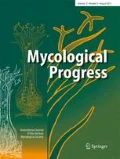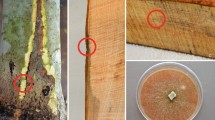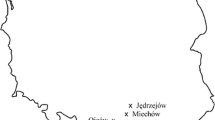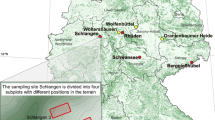Abstract
Fungal colonisation originating from endophytic thalli in wood of healthy European beech trees (Fagus sylvatica) was studied. Fungi were isolated from wood immediately after felling and after incubation for 8, 16 and 24 weeks under two different drying regimes. Two media were used to isolate fungi: malt extract agar with and without thiabendazol. Thiabendazol was added to inhibit non-basidiomycetes. The two drying regimes had no influence on the species composition of the recovered mycobiota and the frequency of isolation of these species. Mycelia of basidiomycetes except Coniophora puteana emerged only from wood samples inoculated onto malt extract agar containing thiabendazol. Only a few isolates were obtained from freshly cut wood, but a great number of isolates was recovered already after eight weeks of wood incubation. Four taxa accounted for 88 % of the total number of isolates: Hypoxylon fragiforme, Trichoderma spp., and the basidio-mycetes Coniophora puteana and Fomes fomentarius. The latter had not been considered an endophyte before. The isolates of F. fomentarius were made exclusively from the stem and some large diameter branches, which are the locations of its basidiocarps on dying trees. Every isolate of F. fomentarius was genetically different as revealed by tests for somatic compatibility. Advantages of the presumed endophytic strategy of F. fomentarius are discussed. Microscopic investigations showed a great number of hyphae within the cell lumina of vessels and a distinct wood degradation already after eight weeks of wood incubation.
Similar content being viewed by others
References
Barengo N, Sieber TN, Holdenrieder O (2000) Diversity of endophytic mycobiota in leaves and twigs of pubescent birch (Betula pubescens). — Sydowia 52: 305–320.
Baum S, Schwarze FWMR (2002) Large-leafed lime (Tilia platyphyllos) has a low ability to compartmentalize decay fungi via reaction zone formation. — New Phytologist 154: 481–490.
Bettucci L, Alonso R, Fernandez LM (1997) A comparative study of fungal populations in healthy and symptomatic twigs and seedlings of Eucalyptus globulus in Uruguay. — Sydowia 49: 109–117.
Bills GF (1996) Isolation and analysis of endophytic fungal communities from woody plants. In Redlin SC, Carris LM (eds.) Endophytic fungi in Grasses and Woody Plants, pp. 31–66. APS Press St. Paul, Minnesota.
Bills GF, Polishook JD (1991) Microfungi from Carpinus caroliniana. — Canadian Journal of Botany 69: 1477–1482.
Bills GF, Polishook JD (1992) Recovery of endophytic fungi from Chamaecyparis thyoides. — Sydowia 44: 1–12.
Boddy L (1994) Latent decay fungi: The hidden foe? — Arboriculture Journal 18: 113–135.
Butin H (1995) Tree Deseases and Disorders. Causes, Biology and Control in Forest and Amenity Trees. Oxford University Press.
Campbell AH (1934) Zone lines in plant tissues. II. The black lines formed by Armillaria mellea. — Annals of Applied Biology 21: 1–22.
Chapela IH (1989) Fungi in healthy stems and branches of American beech and aspen: a comparative study. — New Phytologist 113: 65–75.
Chapela IH, Boddy L (1988a) Fungal colonization of attached beech branches. I. Early stages of development of fungal communities. — New Phytologist 110: 39–45.
Chapela IH, Boddy L (1988b) Fungal colonization of attached beech branches. II. Spatial and temporal organisation of communities arising from latent invaders in bark and functional sapwood, under different moisture regimes. — New Phytologist 110: 47–57.
Chapela IH, Petrini O, Hagmann L (1991) Monolignol glucosides as specific recognition messengers in fungus-plant symbioses. — Physiological and Molecular Plant Pathology 39: 289–298.
Chapela IH, Petrini O, Petrini LE (1990) Unusual ascospore germination in Hypoxylon fragiforme: first steps in the establishment of an endophytic symbiosis. — Canadian Journal of Botany 68: 2571–2575.
Cotter HV, Blanchard RO (1982) The fungal flora of bark of Fagus grandifolia. — Mycologia 74: 836–843.
Felbermeier B, Mosandl R (2002) Monograph of Fagus sylvatica L. In Schütt P, Schuck HJ, Lang U, Rolloff UA (eds.) Enzyklopädie der Holzgewächse, III-2, pp.1–20. Ecomed-Verlag, Landsberg/Lech.
Griffith GS, Boddy L (1990) Fungal decomposition of attached angiosperm twigs. I. Decay community development in ash, beech and oak. — New Phytologist 116: 407–415.
Helander ML, Neuvonen S, Sieber TN, Petrini O (1993) Simulated acid rain affects birch leaf endophyte populations. — Microbial Ecology 26: 227–234.
Kramer H (1988) Waldwachstumslehre. Parey, Hamburg, Berlin.
Lohwag H (1931) Zur Rinnigkeit der Buchenstämme. — Zeitschrift Pflanzlicher Krankheiten 41: 371–385.
Nuss I (1975) Zur Ökologie der Porlinge. Untersuchungen über die Sporulation einiger Porlinge und die an ihnen gefundenen Käferarten. — Bibliotheca Mycologica 45.
Ouellette GB, Methot N, Champerland H, Cote C, Lafontaine J-G (1995) Cytology of irregular growth forms of Ophiostoma ulmi and Ophiostoma novo-ulmi growing through millipore filter membranes and sterilized elm wood sections. — Canadian Journal of Microbiology 41: 1095–1110.
Pearce RB (1990) Occurrence of decay-associated xylem suberization in a range of woody species. — European Journal of Forest Pathology 20: 275–289.
Petrini O (1984) Zur Verbreitung und Ökologie endophytischer Pilze. Habilitationsschrift, ETH Zürich.
Petrini O (1991) Fungal endophytes of tree leaves. In: Andrews JH, Hirano SS (eds.). Microbial ecology of leaves, pp. 179–197. Springer-Verlag, New York.
Pohleven F, Petric M (1997) Comparative wood resistance of beech (Fagus sylvatica L.), paulownia (Paulownia tomentosa Steud.) and eucalypt (Eucalyptus saligna Sm.) against some wood rotting fungi. — Les Ljubljana 49: 365–367.
Ragazzi A, Moricca S, Capretti P, Dellavallei I (1999) Endophytic presence of Discula quercina on declining Quercus cerris. — Journal of Phytopathology 147: 437–440.
Rayner ADM (1986) Water and the origin of decay in trees. In Ayres PG, Boddy L (eds.) Water, fungi and plants, pp. 321–341. Cambridge University Press, Cambridge.
Rice RW, Wengert EM, Schroeder JG (1988) The potential for check reduction using surface coatings. — Forest Products Journal 38: 17–23.
Samuels GJ (1996) Trichoderma: a review of biology and systematics of the genus. — Mycological Research 100: 923–935.
Schwarze FWMR, Baum S (2000) Mechanisms of reaction zone penetration by decay fungi in wood of beech (Fagus sylvatica). — New Phytologist 146: 129–140.
Schwarze FWMR, Engels J, Mattheck C (2000) Fungal Strategies of Wood Decay in Trees. Springer Verlag, Berlin, Heidelberg, New York.
Shigo AL, Marx HG (1977) Compartmentalization of Decay in Trees. Forest Service, United States Department of Agriculture. Agriculture Information Bulletin 405.
Sieber TN (1995) Pyrenochaeta ligni-putridi sp. nov., a new coelomycete associated with butt rot of Picea abies in Switzerland. — Mycological Research 99: 274–276.
Sieber TN, Dorworth CE (1994) An ecological study about assemblages of endophytic fungi in Acer macrophyllum in British Columbia: in search of candidate mycoherbicides. — Canadian Journal of Botany 72: 1397–1402.
Sieber TN, Hugentobler C (1987) Endophytische Pilze in Blättern und Ästen gesunder und geschädigter Buchen (Fagus sylvatica L.). — European Journal of Forest Pathology 17: 411–425.
Sieber TN, Sieber-Canavesi F, Dorworth CE (1991) Endophytic fungi of red alder (Alnus rubra Bong.) leaves and twigs in British Columbia. — Canadian Journal of Botany 69: 407–411.
Stalpers JA (1978) Identification of wood-inhabiting Aphyllophorales in pure culture. — Studies in Mycology 16: 1–248.
Stone JK (1987) Initiation and development of latent infections by Rhabdocline parkeri on Douglas-fir. — Canadian Journal of Botany 65: 2614–2621.
Tavzes C, Pohleven F, Koestler RJ (2001) Effect of anoxic conditions on wood-decay fungi treated with argon or nitrogen. — International Biodeterioration and Biodegradation 47: 225–231.
Videlov K, Rosnev B, Mikhailov B (1987) Investigation on the process of decay of beech (Fagus sylvatica) wood caused by Coniophora puteana. — Gorskostopanska Nauka 24: 45–55.
Worrall JJ (1997) Somatic incompatibility in basidiomycetes. — Mycologia 89: 24–36.
Author information
Authors and Affiliations
Corresponding author
Rights and permissions
About this article
Cite this article
Baum, S., Sieber, T.N., Schwarze, F.W.M.R. et al. Latent infections of Fomes fomentarius in the xylem of European beech (Fagus sylvatica). Mycol Progress 2, 141–148 (2003). https://doi.org/10.1007/s11557-006-0052-5
Accepted:
Issue Date:
DOI: https://doi.org/10.1007/s11557-006-0052-5




